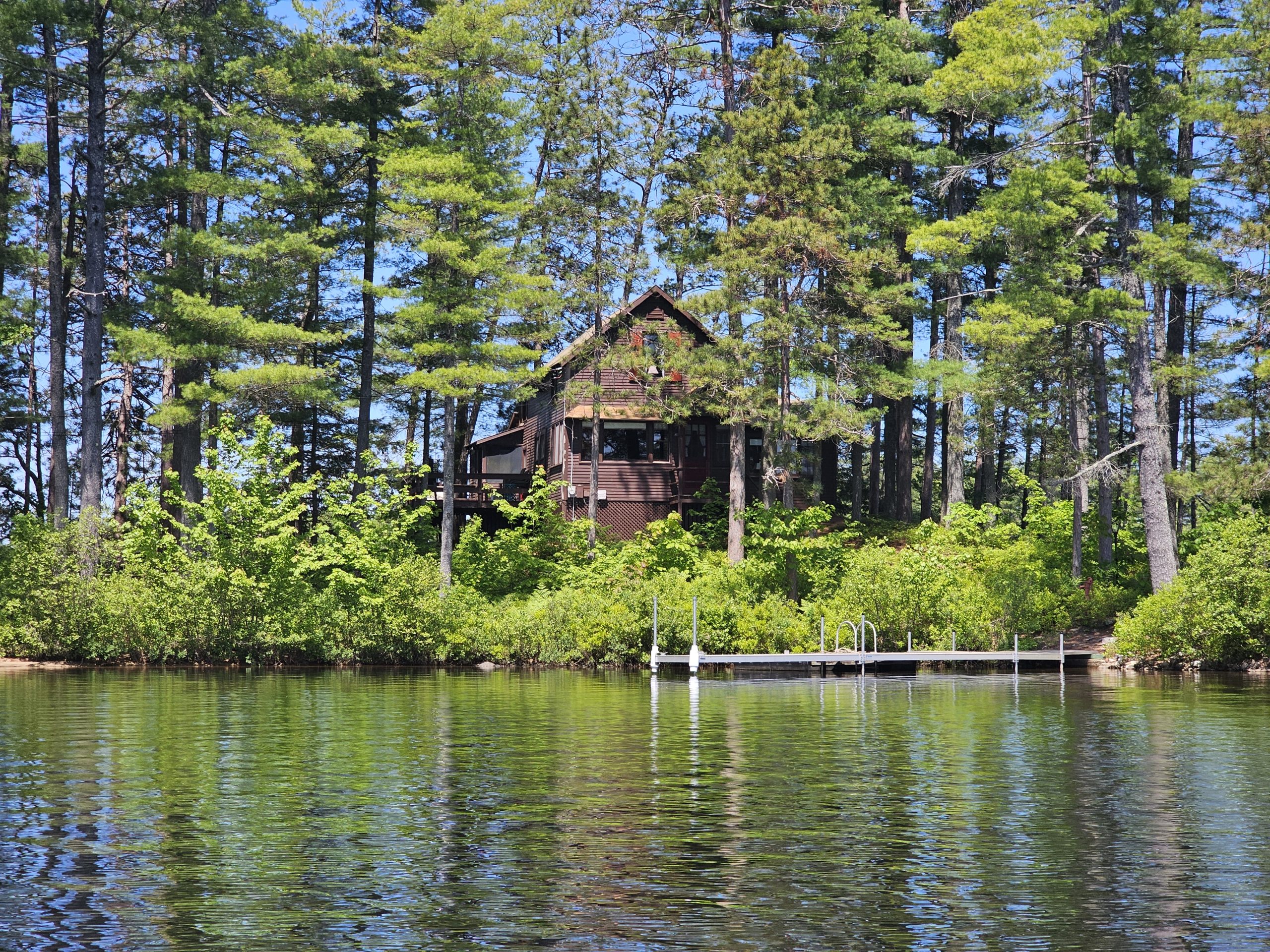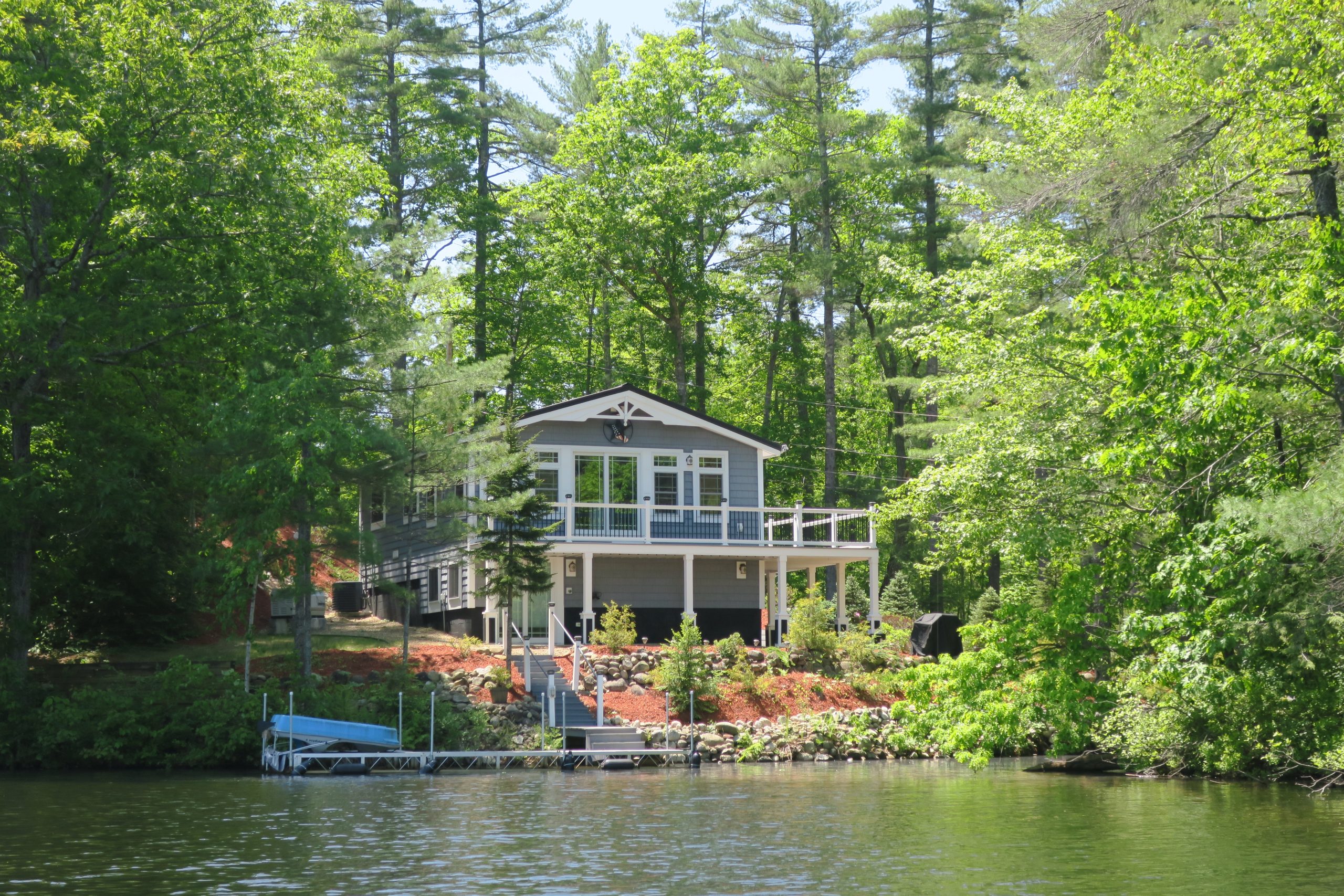Take Action: What You Can Do
Shoreline Vegetated Buffers
A shoreline vegetated buffer is a strip of land along the shoreline, planted with native trees, shrubs, and plants. These buffers filter pollution from rain runoff, protecting the lake and stabilizing the ground. The most natural buffers blend seamlessly with the surrounding forest – picture a cabin set back from the water, with a view peeking through pine trees, ferns, and blueberry bushes.
New! Shoreline Vegetated Buffer Cost-Share Program
Why maintain a shoreline vegetated buffer on your property?
- It keeps the lake clean and healthy by filtering pollutants.
- It enhances the natural beauty of your landscape, blending with nearby forests.
- Once established, it requires little maintenance and becomes stronger over time.
- Buffer plants deter geese while attracting songbirds and butterflies.
- The deep roots of buffer plants prevent erosion and absorb excess water, protecting your land.
The Problem
Lakeside development replaces natural vegetation with roads, driveways, patios, and homes. These structures are impervious, meaning they shed water instead of absorbing it. When rain falls, the runoff from these surfaces-known as stormwater runoff- carries pollutants into the lake if not properly filtered. These pollutants can include fertilizers, herbicides, insecticides, soaps, oil, and bacteria from pet and livestock waste and septic systems. Runoff can also erode the land, washing dirt and attached pollutants into the lake.
Also, during construction, natural vegetation is often removed to make room for construction equipment, lawns, or to match certain aesthetic preferences. Unfortunately, altering naturally vegetated areas along the lake can have serious consequences. A lakefront property’s value – and the overall enjoyment of the lake – depends on the lake’s health. Without natural vegetated buffers to filter pollutants, the lake’s condition declines, leading to harmful effects such as:
- Cyanobacteria and algal blooms, some of which can be toxic to wildlife and people.
- Accumulation of toxic metals in lake organisms, affecting the fish that feed on them.
- Disruption to the lake ecosystem, resulting in invasive aquatic species and loss of fish habitat.
The Solution
There are many ways to help protect the health of a lake, but maintaining a shoreline vegetated buffer is one of the most effective. This natural barrier filters pollutants that wash off impervious surfaces, keeping the water clean.
For some property owners, the best approach is to do nothing – if their property already has a long-established vegetated buffer with a mix of native plants, shrubs, and trees. For others, creating a planting plan is a great first start. The best part? A buffer can start small and expand over time, allowing for gradual improvements.
Well Established Vegetated Buffer vs. New Buffer vs. No Buffer



Questions and Answers
Will a buffer block the view of the lake?
A well-planned buffer can include low-growing plants and shrubs, ensuring an open view. Trees can be pruned to maintain sightlines to the water.
I like to play lawn games with my family, sit on my beach, and watch the sunset from my porch. Where can I fit a vegetated buffer?
Vegetated buffers come in all shapes and sizes! You can design a buffer that fits your property’s layout while leaving space for recreation and relaxation.
I have a lawn. Does that count as a vegetated buffer?
While a lawn helps stabilize the ground, its shallow roots don’t filter pollution from rain and stormwater runoff as effectively as native vegetation. Planting a vegetated buffer between the lawn and the lake is a good compromise. Allowing areas of your lawn to turn wild can also be a fantastic way to grow a vegetated buffer at no cost.
Will a buffer keep geese off my lawn?
Yes! Geese typically swim from the lake and walk onto land. A buffer acts as a natural barrier, making access difficult. Additionally, geese avoid areas of dense vegetation where predators could be lurking.
Does a vegetated buffer require a lot of maintenance?
Once native shoreland plants are established and watered for one or two growing seasons, they require little to no maintenance. Native plants are naturally suited to local conditions, making them a resilient, low-maintenance option.
Is planting a vegetated buffer expensive?
You can plant a buffer gradually over time to spread out costs. Unlike lawns, which require ongoing upkeep, buffers become stronger over time making them a worthwhile long-term investment.
Will I need a permit to plant a buffer?
Neither a New Hampshire Shoreland Permit nor a Maine Natural Resource Protection Act permit is needed to plant native plants with hand-held tools in previously altered areas. However, if living in New Hampshire and planting directly in the bank of the lake, contact the New Hampshire Department of Environmental Services (DES) Wetlands Bureau to confirm a Wetlands Permit is not needed.
Maine DEP Memo: Hand Planting Native Vegetation Adjacent to a Protected Natural Resources
NHDES: Activities That Do Not Require a Shoreland Permit
Resources
Design, Installation, and Maintenance
Native shoreline plants:
- Native Plants of the Northeast
- Native Shoreland Buffer Plantings for New Hampshire
- Native Plant Trust’s Garden Plant Finder tool
